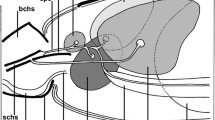Summary
The sinus gland of Cardisoma carnifex was examined by light and transmission electron microscopy. This neurohemal organ is composed primarily of enlarged, branching axon terminals with numerous finger-like projections, which act as storage and release sites for neurohormones that are assumed to be contained in membrane-bound, electron-dense neurosecretory granules. Also present in the sinus gland are glial cells with cytoplasmic processes which form elaborate wrappings around neurosecretory terminals, and an acellular fibrillar lining of the branching blood sinus. Six types of neurosecretory terminals are identified on the basis of granule size, granule density, and density of the axoplasmic matrix. Images supporting the hypothesis of release of neurosecretory material by exocytosis from terminals abutting the blood sinus lining are found. Large multilamellate bodies appear in terminals depleted of neurosecretory granules and may be involved in the recycling of granule membrane.
Similar content being viewed by others
References
Andrew RD, Shivers RR (1976) Ultrastructure of neurosecretory granule exocytosis by crayfish sinus gland induced with ionic manipulations. J Morphol 150:253–278
Andrews PM, Copeland DE, Fingerman M (1971) Ultrastructural study of the neurosecretory granules in the sinus gland of the blue crab, Callinectes sapidus. Z Zellforsch 113:461–471
Berlind A (1977) Cellular dynamics in invertebrate neurosecretory systems. Int Rev Cytol 49:171–251
Bern HA (1963) The secretory neuron as a doubly-specialized cell. In: Mazia D, Tyler A (eds) General physiology of cell specialization. McGraw-Hill, New York, pp 349–366
Bunt AH (1969) Formation of coated and “synaptic” vesicles within neurosecretory axon terminals of the crustacean sinus gland. J Ultrastruc Res 28:411–421
Bunt AH, Ashby EA (1968) Ultrastructural changes in the crayfish sinus gland following electrical stimulation. Gen Comp Endocrinol 10:376–382
Dale HH (1935) Pharmacology and nerve endings. Proc Roy Soc Med 28:319–332
Douglas WW (1973) How do neurones secrete peptides? Exocytosis and its consequences, including synaptic vesicle formation, in the hypothalamo-neurohypophysial system. Progr Brain Res 39:21–38
Douglas WW, Nagasawa J, Schulz RA (1971) Coated microvesicles in neurosecretory terminals of posterior pituitary glands shed their coats to become smooth “synaptic” vesicles. Nature 232:340–341
Elias H (1980) An elementary introduction to stereology (quantitative microscopy). From teaching notes, University of California, San Francisco
Fingerman M, Aoto T (1959) The neurosecretory system of the dwarf crayfish, Cambarellus schefeldti, as revealed by light and electron microscopy. Trans Amer Micr Soc 78:305–317
Gabe M (1966) Neurosecretion. Pergamon Press, Oxford, 872 pp
Hagadorn IR, Bern HA, Nishioka RS (1963) The fine structure of the supraesophageal ganglion of the rhynchobdellid leech, Thermyzon rude, with special reference to neurosecretion. Z Zellforsch 58:714–758
Heuser JE, Reese TS (1973) Evidence for recycling of synaptic vesicle membrane during transmitter release at the frog neuromuscular junction. J Cell Biol 57:315–344
Kleinholz LH (1976) Crustacean neurosecretory hormones and physiological specificity. Amer Zool 16:151–166
Knowles FGW (1959) The control of pigmentary effectors. In: Grabman A (ed) Comparative endocrinology. Wiley, New York, pp 223–232
Knowles FGW (1962) The ultrastructure of a crustacean neurohaemal organ. In: Heller H, Clark RB (eds) Neurosecretion. Mem Soc Endocr No 12. Academic Press, New York, pp 71–88
Lescure H, Nordmann JJ (1980) Neurosecretory granule release and endocytosis during prolonged stimulation of the rat neurohypophysis in vitro. Neurosci 5:651–659
Morris JF, Nordmann JJ (1980) Membrane recapture after hormone release from nerve endings in the neural lobe of the rat pituitary gland. Neurosci 5:639–649
Nagasawa J, Douglas WW, Schulz RA (1971) Micropinocytotic origin of coated and smooth microvesicles (“synaptic vesicles”) in neurosecretory terminals of posterior pituitary glands demonstrated by incorporation of horseradish peroxidase. Nature 232:341–342
Nordmann JJ (1977) Ultrastructural appearance of neurosecretory granules in the sinus gland of the crab after different fixation procedures. Cell Tissue Res 185:557–563
Nordmann JJ, Morris JF (1976) Membrane retrieval in neurosecretory axon endings. Nature 261:723–725
Nordmann JJ, Morris JF (1980) Depletion of neurosecretory granules and membrane retrieval in the sinus gland of the crab. Cell Tissue Res 205:31–42
Nordmann JJ, Dreifuss JJ, Baker PF, Ravazzola M, Malaisse-Lague F, Orci L (1974) Secretion-dependent uptake of extracellular fluid by the rat neurohypophysis. Nature 250:155–157
Normann TC (1969) Experimentally induced exocytosis of neurosecretory granules. Exp Cell Res 55:285–287
Normann TC (1976) Neurosecretion by exocytosis. Int Rev Cytol 46:1–77
Potter DD (1956) Observations on the neurosecretory system of portunid crabs. PhD Thesis, Harvard University
Rehm M (1959) Observations on the localisation and chemical constitution of neurosecretory material in nerve terminals of Carcinus maenas. Acta Histochem 7:88–106
Reynolds ES (1963) The use of lead citrate at high pH as an electron-opaque stain in electron microscopy. J Cell Biol 17:208–211
Shivers RR (1976) Exocytosis of neurosecretory granules from the crustacean sinus gland in freeze-fracture. J Morphol 150:227–252
Silverthorn SU (1975) Neurosecretion in the sinus gland of the fiddler crab, Uca pugnax. Cell Tissue Res 165:129–133
Smith G (1974) The ultrastructure of the sinus gland of Carcinus maenas (Crustacea: Decapoda). Cell Tissue Res 155:117–125
Smith U (1970) The origin of small vesicles in neurosecretory axons. Tissue Cell 2:427–433
Watson ML (1958) Staining of tissue for electron microscopy with heavy metals. J Biophys Biochem Cytol 4:727–730
Weibel ER (1969) Stereological principles for morphometry in electron microscopic cytology. Int Rev Cytol 26:235–302
Weibel ER (1973) Stereological techniques for electron microscopic morphometry. In: Hayat MA (ed) Principles and techniques of electron microscopy. Vol 3 Biological applications. Van Nostrand Reinhold, New York, pp 239–296
Author information
Authors and Affiliations
Rights and permissions
About this article
Cite this article
Weatherby, T.M. Ultrastructural study of the sinus gland of the crab, Cardisoma carnifex . Cell Tissue Res. 220, 293–312 (1981). https://doi.org/10.1007/BF00210510
Accepted:
Issue Date:
DOI: https://doi.org/10.1007/BF00210510




